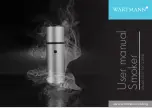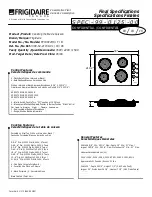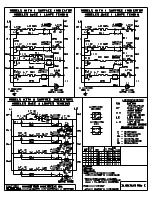
29
BETTY THERMO
cod.
395100020
- 12/2010
29/60
GB
D
6 INSTALLATION
6.1 PLACE OF INSTALLATION
Adjacent walls and the floor it is going to stand on
should be in a non-combustible, non-heat sensitive
material. To the contrary use appropriate protection in
insulating and non-combustible material.
If the floor is made of inflammable material before
positioning the cooker we suggest laying a 2-3 mm
thick metal plate that juts out by at least 80 cm from
the front of the cooker (Fig. 6.1).
The cooker should also be kept at a minimum safety
distance of approximately 30 cm from the surrounding
walls.
Any claddings in combustible material above the
cooker (for example beams and wooden ceilings)
must be screened by diaphragms in non-combustible
insulating material.
Leave a space around the cooker to gain access for
maintenance purposes.
6.2 ARIA COMBURENTE
While it is operating, the cooker uses a modest quantity
of air taken from the room in which is it installed: this
air must be replaced by means of an air intake outside
the room itself (Fig. 6.1;
A
external air intake).
The
EXTERNAL AIR INTAKE
is indispensable to ensure
a suitable flow of
COMBUSTION AIR,
especially if doors
and windows are double-glazed and sealed.
If the wall behind the cooker is an outside wall, make
a comburent air inlet hole at a height from the floor of
about 20-30 cm.
If several cookers are installed in the same place, it is
advisable to increase the cross-section of the external
air intake for each cooker to avoid low air pressure
and consequent formation of smoke.
The hole must be protected, on the outside with a
permanent ventilation grille suitable to prevent insects
and small animals from entering. In particularly windy
areas that are exposed to bad weather it is advisable
to install a rain and wind guard.
If the wall behind the cooker is not an outside one, it is
possible to make a hole connecting to the outside on
an adjacent wall as long as it communicates
permanently with the rooms in which the stoves are
installed by means of a transit grille.
!
The UNI 10683 standard forbids taking air for
combustion from garages, rooms where flammable
materials are stored or where there is danger of
fire.
!
The external intake hole for combustion air must
not be connected to the cooker with a pipe.
!
If there are other heating appliances in the same
room, the combustion air intakes must be able to
guarantee the necessary volume of air to ensure
correct operation of all the devices.
6 INSTALLATION
6.1 OBERE ABDECKUNG
Nebenliegende Wände und Stellfläche müssen aus
feuerfestem und wärmebeständigem Material sein;
andernfalls muss für angemessene
Schutzvorrichtungen aus feuerfestem Isoliermaterial
gesorgt werden.
Bevor der Herd in seine endgültige Position gestellt
wird, bei nicht feuerfestem Bodenbelag eine 2-3 mm
starke Metallplatte verlegen, die ca. 80 cm weit unter
dem Herd nach vorne hinaus ragen soll (Abb. 6.1).
Es muss außerdem ein Sicherheitsabstand von
mindestens 30 cm zu den umliegenden Wänden
eingehalten werden.
Eventuelle über dem Herd befindliche Abdeckungen
aus brennbarem Material (z.B. Holzbalken und -
decken) müssen mit Hilfe von Blenden aus
feuerfestem Isoliermaterial abgeschirmt werden.
Für eventuelle Instandhaltungsarbeiten den nötigen
Raum frei lassen.
6.2 VERBRENNUNGSLUFT
Der Herd entnimmt dem Aufstellungsraum während
seines Betriebs eine geringe Luftmenge; diese Luft muss
über eine Luftzufuhr von außen zum Raum hin wieder
zugeführt werden (Abb. 6.1,
A
Luftzufuhr von außen).
Die
LUFTZUFUHR VON AUSSEN
ist zur
Gewährleistung des Zuflusses der
VERBRENNUNGSLUFT
unbedingt und insbesondere
bei doppelten Fensterscheiben und Dichtungen nötig.
Sollte die Wand hinter dem Herd eine Außenwand
sein, daran ein Loch vom Fußboden von ca. 20-30
cm bohren.
Sollten im gleichen Raum mehrere Feuerstätten
vorhanden sein, ist der Querschnitt der Außenluftzufuhr
für jedes Gerät zu vergrößern, um eine Unterdruckbildung
und das Austreten von Rauch zu vermeiden.
Das Loch muss außen mit einem fix angebrachten
Schutzgitter abgedeckt werden, um den Durchgang
für Insekten und kleine Tiere zu versperren; in
besonders windigen und der Witterung ausgesetzten
Bereichen ist ein Regen- und Windschutz vorzusehen.
Sollte die Wand hinter dem Herdkeine Außenwand
sein, ist das Loch an einer Außenwand des
Installationsraums zu bohren.
Sollte keine der Wände des Installationsraums eine
Außenmauer sein, kann das Loch in einem
angrenzenden Raum gebohrt werden, wobei der
Luftaustausch zwischen den beiden Räumen jedoch
durch die Installation eines Lüftungsgitters ständig
gewährt werden muss.
!
Die UNI-Norm 10683 untersagt die Frischluftzufuhr
aus Garagen, Brennstoff-Lagerräumen oder
Räumen in denen feuergefährliche Aktivitäten
ausgeführt werden.
!
Die Öffnung zur Verbrennungsluftzufuhr darf nicht
mittels Rohrleitung an den Herd angeschlossen
werden.
Summary of Contents for ALBA IDRO
Page 2: ......
















































